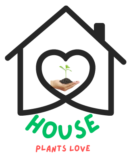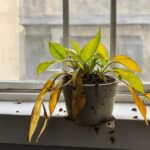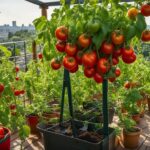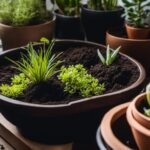Indoor houseplant Pests and diseases type, Symptoms, Effective treatment, prevention method, Organic and Chemical Pest Control, Natural and Chemical Solutions Remedies
Pest attacks on houseplants can be a hassle to deal with, but fear not! With the right knowledge and prevention methods, you can keep your plants healthy and free from pesky pests and diseases. In this article, I will guide you through the types of houseplant pests and diseases to watch out for and provide tips on how to treat them.

Common houseplant pests and diseases include aphids, centipedes, mealybugs, red spider mites, scale insects, sciarid flies, slugs, springtails, and thrips. Each pest comes with its own identifying symptoms and requires specific treatments for effective control. By understanding the signs and taking proactive measures, you can protect your beloved indoor plants.
Key Takeaways:
- Houseplant pests can be prevented and controlled with the right knowledge.
- Common houseplant pests include aphids, mealybugs, red spider mites, and more.
- Identifying the symptoms of houseplant pest infestations is crucial for effective treatment.
- Natural remedies like neem oil and insecticidal soap are effective in managing pests.
- Chemical solutions may be necessary for severe pest infestations.
Organic and Chemical Control of Houseplant pests and diseases
When it comes to managing houseplant pests, you have the option of using organic or chemical pest control methods. Organic methods provide a more natural approach to pest control, while chemical solutions can offer a more powerful and targeted solution for severe infestations. Let’s explore both options in more detail.
Organic Pest Control of Houseplant pests and diseases
Organic pest control involves using natural remedies that are safe for both your plants and the environment. One popular organic option is neem oil, which is derived from the neem tree and acts as a natural insecticide and fungicide. It is effective against a wide range of common houseplant pests, including aphids, mealybugs, and spider mites. To use neem oil, simply mix it with water according to the instructions on the bottle and spray it onto your plants.
Another organic option is homemade sprays. These can be made using ingredients such as garlic, onion, or hot pepper, which act as natural repellents for pests. Simply blend the chosen ingredient with water, strain the mixture, and spray it onto your plants. Homemade sprays are versatile and can be customized based on your specific needs and the pests you’re dealing with.
Chemical pests and diseases Control of Indoor Plants
In some cases, organic methods may not be sufficient to control a severe infestation. Chemical solutions can provide a more powerful and targeted approach to pest control. Permethrin and pyrethrin-based products are commonly used to combat a variety of houseplant pests, including aphids, mealybugs, and thrips. These products work by disrupting the nervous system of the pests, leading to their eventual demise. It’s important to carefully follow the instructions on the product label and take the necessary precautions when using chemical pesticides.
| Pests and diseases Control Method | Pros | Cons |
|---|---|---|
| Organic | – Environmentally friendly – Safe for plants and pets – Natural and non-toxic | – May require more frequent application – May not be as effective against severe infestations |
| Chemical | – Powerful and targeted – Quick results – Effective against severe infestations | – May be harmful to beneficial insects – Potential for chemical residue on plants – Requires careful handling and following instructions |
When choosing between organic and chemical pest control methods, it’s important to consider the specific pest you’re dealing with, the severity of the infestation, and your personal preferences as a gardener. Some gardeners prefer to use organic methods whenever possible to minimize their environmental impact, while others prioritize quick and effective results. Ultimately, the choice is yours, and you can experiment with different methods to find what works best for you and your houseplants.
You can also read about Marigold Flowers Planting & Caring Guide
Common Houseplant pests and diseases Types and Their Symptoms
Identifying indoor plant pests early on is crucial for effective pest control. Different pests have distinct symptoms that can help you pinpoint the problem and take appropriate action. Here are some common indoor plant pests and their symptoms:
Aphids (Aphidoidea):
Aphids are tiny, soft-bodied insects that can quickly multiply and infest your houseplants. They come in various colors, including green, brown, and black. Signs of aphid infestation include:
- Curling leaves: Aphids often congregate on the undersides of leaves, causing them to curl.
- Sticky residue: Aphids secrete a sticky substance called honeydew, which can attract mold and make leaves appear shiny.
- Symptoms: Aphids are small, pear-shaped insects that can be green, yellow, or black. They often cluster on new plant growth and the undersides of leaves. Look for distorted or curled leaves, sticky honeydew deposits, and the presence of black sooty mold.
Mealybugs (Pseudococcidae):
Mealybugs are small, soft-bodied insects covered in a waxy, cotton-like substance. They often cluster in leaf axils, joints, and other protected areas. Signs of mealybug infestation include:
- White, cottony masses: Mealybugs are easily identifiable by the white, cottony substance they produce.
- Stunted growth and yellowing: Mealybugs feed on plant sap, causing stunted growth and yellowing of leaves.
- Symptoms: Mealybugs are small, soft-bodied insects covered in a white, cottony material. They infest plant stems, leaves, and the soil. Look for wilted, yellowing leaves, honeydew secretions, and the presence of the cottony material.
Spider Mites (Tetranychidae):
Spider mites are microscopic arachnids that can wreak havoc on your houseplants. They thrive in dry conditions and are known for spinning fine webs on leaves. Symptoms of spider mite infestation include:
- Webbing: Fine silk webbing on leaves and between stems is a clear sign of spider mites.
- Bronzed or stippled leaves: Spider mites feed by piercing plant cells, leading to a stippled appearance on leaves.
- Symptoms: Red spider mites are tiny, eight-legged pests that leave behind fine webbing on the plant. They feed on plant sap and cause mottled leaves with yellow or brown spots. Infested plants may also have a dusty appearance.
Whiteflies (Aleyrodidae):
Whiteflies are tiny insects with white wings that quickly take residence on the undersides of leaves. They feed on plant sap and can cause considerable damage. Symptoms of whitefly infestation include:
- Sticky honeydew: Similar to aphids, whiteflies excrete honeydew, leading to a sticky residue on leaves.
- Yellowing and wilting: Whiteflies can transmit viruses that cause yellowing and wilting of leaves.
You can also read about Best Gravel For Houseplants.
Fungus Gnats (Sciaridae):
Fungus gnats are small, mosquito-like insects that lay their eggs in the soil of houseplants. The larvae feed on organic matter in the soil and can damage plant roots. Signs of fungus gnat infestation include:
- Visible adult gnats: Adult fungus gnats are small, flying insects often seen around the soil surface.
- Yellowing and stunted growth: Larvae can damage roots, leading to poor plant health.
Scale Insects (Coccidae):
Scale insects are small, oval-shaped pests that attach themselves to plant stems and leaves, feeding on plant juices. Signs of scale infestation include:
- Small, raised bumps: Scales appear as small, waxy bumps on stems and leaves.
- Yellowing or wilting: Heavy-scale infestations can lead to plant stress, causing yellowing and wilting.
- Symptoms: Scale insects have a hard outer shell that protects their soft bodies. They can be brown, black, or tan in color and range in size from tiny specks to larger bumps on plant stems and leaves. Look for sticky honeydew residue, yellowing or wilting leaves, and stunted growth.
By familiarizing yourself with these signs of houseplant pests, you can quickly identify the problem and take the necessary steps to eliminate the infestation. Remember to regularly inspect your plants and be proactive in your pest control efforts for healthy, thriving houseplants.
Effective Ways to Treat Houseplant Pests and diseases
When it comes to dealing with houseplant pests, there are several effective ways to treat and control them. Whether you prefer natural remedies or chemical solutions, there are options available to suit your needs. Here are some effective methods to consider:
Natural Remedies
Using natural remedies can be a safe and effective way to treat houseplant pests.
- insecticidal soap is one popular option, which works by suffocating and killing pests on contact. Simply mix the soap with water according to the instructions and spray it onto the affected plants.
- Neem oil is another natural remedy that works by disrupting the pests’ feeding and reproductive systems. It can be applied directly to the leaves of infested plants. Spraying infested plants with water can also help to dislodge and remove pests.
- Additionally, wiping off insects with rubbing alcohol-soaked cotton swabs can be an effective method for control.
Chemical Solutions
In some cases, a stronger solution may be needed to combat severe infestations. Chemical solutions such as permethrin or certain insecticidal soaps can be effective in controlling pests. These products are specifically formulated to target and eliminate a wide range of pests. However, it is important to carefully follow the instructions provided with these products to ensure safe and effective use. Chemical control should be used as a last resort and only when necessary.
| Method | Description |
|---|---|
| Insecticidal Soap | A natural remedy that suffocates and kills pests on contact. |
| Neem Oil | A natural remedy that disrupts pests’ feeding and reproductive systems. |
| Spraying with Water | Helps to dislodge and remove pests from infested plants. |
| Rubbing Alcohol | Wiping off insects with alcohol-soaked cotton swabs for control. |
| Permethrin | A chemical solution for severe infestations, targeting a wide range of pests. |
| Insecticidal Soaps | Chemical solutions specifically formulated to control pests. |
By using these effective methods, you can successfully treat houseplant pests and keep your plants healthy. Remember to always read and follow the instructions provided with any pest control product and consider the severity of the infestation before choosing a treatment method. With proper care and attention, you can ensure that your houseplants thrive and remain pest-free.
Conclusion
Managing houseplant pests is crucial for the health and longevity of your indoor plants. By implementing effective prevention and control measures, you can keep these pesky pests at bay and enjoy a thriving greenery in your home.
To prevent houseplant pest infestations, regular inspection is key. Take the time to thoroughly examine your plants for any signs of pests or damage. By catching the problem early on, you can prevent it from spreading and causing further harm.
Proper plant care is also essential in preventing infestations. Providing your houseplants with the right amount of light, water, and nutrients will help strengthen their defences against pests. Additionally, avoid overwatering or overcrowding your plants, as these conditions can create a favourable environment for pests to thrive.
If an infestation does occur, swift action is necessary to control and eliminate the pests. Depending on the severity of the infestation, you can choose between organic or chemical pest control methods. Organic remedies like insecticidal soap, neem oil, and spraying with water can be effective for mild infestations. For more severe cases, chemical solutions such as permethrin or pyrethrin-based products may be necessary.
Remember, the key to successful houseplant pest management is a proactive approach. Regularly inspect, care for, and address any pest issues promptly. With these strategies in place, you can maintain a pest-free environment for your houseplants and enjoy their beauty and benefits for years to come.
FAQ
How can I prevent pest attacks on my houseplants?
Regular inspection, proper care, and using organic or chemical pest control methods when necessary are essential in maintaining the health and beauty of your indoor plants.
What are the common houseplant pests I should be aware of?
Common houseplant pests include aphids, centipedes, mealybugs, red spider mites, scale insects, sciarid flies, slugs, springtails, and thrips.
What are the symptoms of aphids and how can I treat them?
Aphids are typically found on new plant growth and can be identified by their massing together in colonies and the presence of sticky honeydew deposits. For treatment, you can try natural remedies like insecticidal soap, neem oil, or spraying the infested plants with water to dislodge the pests. Wiping off insects with rubbing alcohol-soaked cotton swabs can also be effective.
How can I control houseplant pests using organic methods?
Organic methods, such as using neem oil or homemade sprays, provide a more natural approach to pest eradication. You can try natural remedies like insecticidal soap, neem oil, or spraying infested plants with water to dislodge the pests. Wiping off insects with rubbing alcohol-soaked cotton swabs can also be effective.
What if my houseplant pests require chemical solutions?
Certain pests may require the use of chemical solutions, such as permethrin or pyrethrin-based products. It’s important to consider the specific pest and the severity of the infestation when choosing the appropriate control method. Follow the instructions for each method carefully to ensure effective pest control.




